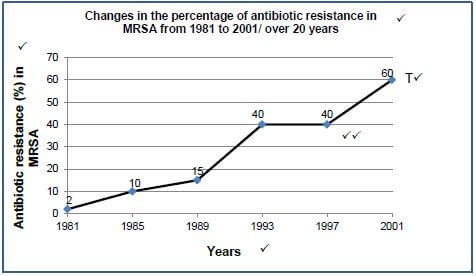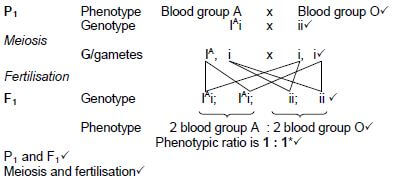LIFE SCIENCES PAPER 2 GRADE 12 MEMORANDUM - NSC PAST PAPERS AND MEMOS FEBRUARY/MARCH 2017
Share via Whatsapp Join our WhatsApp Group Join our Telegram GroupLIFE SCIENCES
PAPER 2
GRADE 12
NSC PAST PAPERS AND MEMOS
FEBRUARY/MARCH 2017
PRINCIPLES RELATED TO MARKING LIFE SCIENCES
- If more information than marks allocated is given
Stop marking when maximum marks is reached and put a wavy line and 'max' in the right-hand margin. - If, for example, three reasons are required and five are given
Mark the first three irrespective of whether all or some are correct/incorrect. - If whole process is given when only a part of it is required
Read all and credit the relevant part. - If comparisons are asked for, but descriptions are given
Accept if the differences/similarities are clear. - If tabulation is required, but paragraphs are given
Candidates will lose marks for not tabulating. - If diagrams are given with annotations when descriptions are required
Candidates will lose marks. - If flow charts are given instead of descriptions
Candidates will lose marks. - If sequence is muddled and links do not make sense
Where sequence and links are correct, credit. Where sequence and links are incorrect, do not credit. If sequence and links become correct again, resume credit. - Non-recognised abbreviations
Accept if first defined in answer. If not defined, do not credit the unrecognised abbreviation, but credit the rest of the answer if correct. - Wrong numbering
If answer fits into the correct sequence of questions, but the wrong number is given, it is acceptable. - If language used changes the intended meaning
Do not accept. - Spelling errors
If recognisable, accept the answer, provided it does not mean something else in Life Sciences or if it is out of context. - If common names are given in terminology
Accept, provided it was accepted at the national memo discussion meeting. - If only the letter is asked for, but only the name is given (and vice versa)
Do not credit. - If units are not given in measurements
Candidates will lose marks. Memorandum will allocate marks for units separately. - Be sensitive to the sense of an answer, which may be stated in a different way.
- Caption
All illustrations (diagrams, graphs, tables, etc.) must have a caption. - Code-switching of official languages (terms and concepts)
A single word or two that appear(s) in any official language other than the learner's assessment language used to the greatest extent in his/her answers should be credited, if it is correct. A marker that is proficient in the relevant official language should be consulted. This is applicable to all official languages. - Changes to the memorandum
No changes must be made to the memoranda. The provincial internal moderator must be consulted, who in turn will consult with the national internal moderator (and the Umalusi moderators where necessary). - Official memoranda
Only memoranda bearing the signatures of the national internal moderator and the Umalusi moderators and distributed by the National Department of Basic Education via the provinces must be used.
MEMORANDUM
SECTION A QUESTION 1
1.1
1.1.1 B✓✓
1.1.2 C✓✓
1.1.3 B✓✓
1.1.4 D✓✓
1.1.5 C✓✓
1.1.6 B✓✓
1.1.7 A✓✓
1.1.8 D✓✓ ( 8 x 2) (16)
1.2
1.2.1 (Gene) mutation✓
1.2.2 Theory✓
1.2.3 Artificial selection✓/Selective breeding
1.2.4 Ribose✓sugar
1.2.5 Punctuated equilibrium✓
1.2.6 Out of Africa✓hypothesis
1.2.7 Fossils✓ (7 x 1) (7)
1.3
1.3.1 A only✓✓
1.3.2 Both A and B✓✓
1.3.3 B only✓✓ (3 x 2) (6)
1.4
1.4.1
- 25✓ mya (accept 24 to 25) (1)
- 63✓ mya (1)
1.4.2 Old World monkeys✓ and apes✓ (2)
(MARK FIRST TWO ONLY)
1.4.3 Lorises✓ (1) (5)
1.5
1.5.1 23✓ (1)
1.5.2
- Centromere✓ (1)
- Chiasma✓/chiasmata (1)
1.5.3 Ovary✓ (1)
1.5.4
- Crossing over✓ (1)
- Prophase I✓ (1)
- ova✓/gametes/sex cells (1)
1.5.5 C? B? A✓(correct sequence) (1) (8)
1.6
1.6.1
- BbTt✓✓ (2)
- Black coat✓ short tail✓ (2)
- BbTt✓ (1)
1.6.2 0✓% (1)
1.6.3 Bt✓ bT✓
(MARK FIRST TWO ONLY) (2) (8)
TOTAL SECTION A: 50
SECTION B
QUESTION 2
2.1
2.1.1 A transitional fossil shows characteristics✓ of two✔/between genera/species (2)
2.1.2 Bipedalism✓/stood upright (1)
2.1.3
- Structure of the pelvis✓
- Cranial volume✓
(MARK FIRST ONE ONLY) Any 1 (1)
2.1.4
- The foramen magnum is located more forward beneath the skull✓, so that \
- the vertebral column extends beneath✓ the skull. - The spine is S-shaped ✓to
- support an upright posture✓
- The pelvis is shorter and wider✓
- to support the body above✓the pelvis
(MARK FIRST TWO ONLY) Any (2 x 2) (4)
2.1.5
- There was a change in diet✓
- from tough✓/raw to
- softer✓/cooked food (3) (11)
2.2
2.2.1
- MRSA✓ (1)
- FQRP✓ (1)
2.2.2 (20-5)✓ × 100✓ OR (15)✓ × 100✓
5 1 5 1
= 300✓% (3)
2.2.3 
Mark allocation for the graph
Criteria | Mark Allocation |
Correct type of graph (line graph) | 1 |
Title of graph including both variables | 1 |
Correct label and scale for X-axis | 1 |
Correct label and scale for Y-axis | 1 |
Plotting of points | 1 – 1 to 5 points plotted correctly |
NOTE:
If the wrong type of graph is drawn, marks will be lost for:
- 'Correct type of graph'
- 'Plotting of points'
If the axes are transposed:
The learner will lose 2 marks for correct label and scale for x and y axes
If learners draw all 3 graphs on the same system of axes:
- Learners will lose the mark for the title
- Learners will lose 1 mark for correct label and scale for y axis
- If all three graphs drawn are labelled, mark the correct MRSA graph
- If all three graphs drawn are not labelled, marks for plotting will be lost
If learners draw three graphs separately mark the first graph (6) (11)
2.3
2.3.1 DNA✓ (1)
2.3.2 First triplet base✓/ TAT /TAG became TAT (1)
2.3.3
- GUU✓✓ (2)
- Isoleucine✓✓ (2) (6)
2.4
- Double-stranded DNA unwinds✓
- and unzips✓
- when the hydrogen bonds break✓
- One strand is used as a template✓
- to form mRNA✓
- using free RNA nucleotides from the nucleoplasm✓
- the mRNA is complementary to the DNA✓
- The coded message for protein synthesis is thus copied onto mRNA✓ Any 4 (4)
2.5
2.5.1
- Male✓ with Tay Sachs disease✓/all 4 symptoms must be given blind, deaf, mentally retarded and paralysed/ lose motor skills and mental functions (2)
- Nn✓✓ (2)
- Nn✓✓ (2)
2.5.2
- Since Elizabeth has Tay-Sachs disease✓/nn she had to inherit one recessive allele from each of her parents✓/Portia and Patrick. (2)
- Patrick's genotype is Nn✓/heterozygous which means he is a carrier but normal. (Any 2) (2) (8)
[40]
QUESTION 3
3.1
3.1.1 Mary✓✓
(MARK FIRST ONE ONLY) (2)
3.1.2 There are no matching bands✓/bars/pattern/DNA profile with both parents✓ (2) (4)
3.2
3.2.1 Three✓/3 (1)
3.2.2 IA✓ and IB✓ (2)
(MARK FIRST TWO ONLY)
3.2.3  *1 compulsory mark + Any 6
*1 compulsory mark + Any 6
OR
| P1 | Phenotype | Blood group A | x | Blood group O✓ | ||||||||||
| Genotype | IAi | x | ii✓ | |||||||||||
| Meiosis |
| |||||||||||||
| Fertilisation | ||||||||||||||
| F1 | Phenotype | 2 blood group A | 2 blood group O✓ | Phenotypic ratio is 1 : 1*✓ | ||||||||||
P1 and F1✓
Meiosis and fertilisation✓
*1 compulsory mark + Any 6 (7) (10)
3.3
- An individual inherits one allele from each parent✓
- The Y chromosome was inherited from the father✓
- and the recessive allele/Xh was inherited from the mother✓
- since the mother has two recessive alleles✓/Xh Xh
- A son only needs to get one recessive allele to be haemophiliac✓since the
- Y-chromosome does not carry any allele to mask the haemophilia allele✓ Any 4 (4)
3.4
3.4.1
- Determine time/day to collect data✓
- Selected an area✓on the island
- randomly captured✓ a number of birds of the same species
- measured their beaks✓
- before the drought✓
- and during the drought✓
- recorded✓ the number of birds with each beak size
(MARK FIRST FOUR ONLY) Any 4 (4)
3.4.2 Number of finches before and during the drought✓/(beak size) (1)
3.4.3 During the drought there were more finches with larger beaks✓✓ OR During the drought there were fewer finches with smaller beaks✓✓ (2)
3.4.4
- During the drought only hard woody seeds remained✓
- Finches with bigger beaks could crack open the seeds more easily✓
- had sufficient food✓
- and survived✓ and reproduced
OR - During the drought, there were no small, soft seeds✓
- Finches with smaller beaks could not crack open the hard woody seeds✓
- and had no food✓
- did not survive✓to reproduce Any 3 (3)
3.4.5 Range (9,8 – 10,3✓) mm/larger (1) (11)
3.5
3.5.1
- Cloning✓ (1)
- Oogenesis✓/gametogenesis/ meiosis (1)
3.5.2
- The donor horse has the desired characteristics✓
- that need to be copied✓
- and be present in the offspring✓/next generation Any 2 (2)
3.5.3 The nucleus contains all the genetic information✓✓/ hereditary characteristics/chromosomes of the champion horse
3.5.4
- 64✓ (1)
- 32✓ (1)
- 64✓ (1)
3.5.5
- A gamete is generally haploid✓
- This ovum is diploid✓ since
- it has the nucleus of a somatic cell ✓ Any 2 (2)
(11)
[40]
TOTAL SECTION B: 80
SECTION C
QUESTION 4
Natural selection and speciation
- The original species of anole lizards was separated✓S
- into different populations✓S
- by a geographical barrier✓S
- which is the sea✓S
- There was no gene flow✓S
- between the separated populations✓S
- Each population was exposed to different environmental conditions✓N on each island
- Because there is variation✓N amongst the lizards
- Natural selection occurred independently✓N in each population
- Some had favourable characteristics✓N to survive on a specific island
- while others did not✓N
- The ones that did not have the favourable characteristics died✓N
- The ones with the favourable characteristic survived✓N
- and reproduced✓N
- to pass the gene for the favourable characteristics✓N
- to the next generation✓N
- And over many generations the favourable characteristic becomes more frequent in the population✓N
- each population became different from the other✓S over time
- genotypically ✓S
- and phenotypically✓S
- Even if the populations were to mix again✓S
- they would not be able to reproduce/interbreed with each other✓S Max 17
NOTE: ✔S = SPECIATION
✔N = NATURAL SELECTION
Content: (17)
Synthesis: (3)
(20)
ASSESSING THE PRESENTATION OF THE ESSAY
Criterion | Relevance (R) | Logical sequence (L) | Comprehensive (C) |
Generally |
|
|
|
In this essay (Q4) |
|
|
|
Mark | 1 | 1 | 1 |
TOTAL SECTION C: 20
GRAND TOTAL: 150